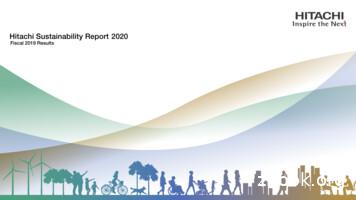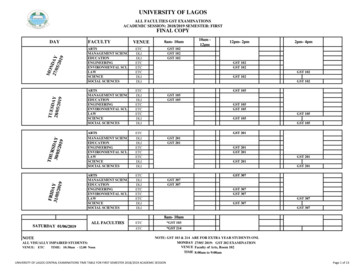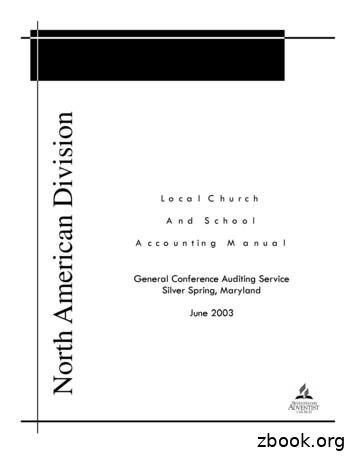Tutorial Letter 102/0/2020 - Unisa
TAX4861/102/0/2020NTA4861/102/0/2020Tutorial Letter 102/0/2020ADVANCED TAXATIONTAX4861NTA4861Department of Financial IntelligenceThis tutorial letter contains important information aboutyour module.
2TAX4861/102/2020NTA4861/102/2020TABLE OF CONTENTSA.INTRODUCTION TO THE MODULE . 3B.SAICA EXAMINABLE PRONOUNCEMENTS . 3C.UNISA’S OPEN-BOOK POLICY. 4D.TUTORIAL LETTERS (OFFICIAL STUDY MATERIAL TAB on myUNISA). 4E.ADDITIONAL RESOURCES (on myUNISA) . 9F.NOTES ON EXAMINATION TECHNIQUE . 9G.SAICA TAX CASE LAW SYLLABUS . 11H.COMPILERS . 12LEARNING UNIT 1 - INTERPRETATION AND APPLICATION OF LEGISLATION . 13ANNEXURE A: CASE LAW SUMMARIES . 17CHAPTER 1 - VALUE-ADDED TAX (study with TL 103) . 17CHAPTER 2 - GROSS INCOME (study with TL 104) . 21CHAPTER 3 - THE GENERAL DEDUCTION FORMULA (study with TL 105) . 29CHAPTER 4 - OTHER MISCELLANEOUS TOPICS (study with TL 104 - TL 107) . 33ANNEXURE B: FULL CITATION OF PRESCRIBED CASE LAW IN ALPHABETICAL ORDER . 38
3A.TAX4861/102/2020NTA4861/102/2020INTRODUCTION TO THE MODULEThe content (syllabus) of this module is based on South African tax law. The South African tax acts(legislation), e.g. the Income Tax Act and the Value-Added Tax Act are the main sources of tax law. Theseacts (statutory authority) are interpreted together with relevant case law, Regulations and Binding GeneralRulings. The interpretation and application of tax law will be explained in Learning Unit 1 below.Tax laws are amended every year and it is for this reason that you should obtain new taxation text booksevery year and not study from old text books.B.SAICA EXAMINABLE PRONOUNCEMENTSThis module serves as preparation for TAX4862 (CTA level 2), which is accredited by the South AfricanInstitute of Chartered Accountants (hereafter SAICA). Therefore, the SAICA Taxation ExaminablePronouncements for the 2021 Initial Test of Competence (ITC) are used as a guideline to determine whichsections of the taxation acts and case law need to be studied.The following needs to be noted on the SAICA Examinable Pronouncements for the 2021 ITC:The cut-off date for taxation legislation examinable in the ITC for 2021, which is also applied in thismodule, is as follows:Amendments promulgated by 31 January 2020* and which are effective for the 2020 year ofassessment. In other words, all amendments effective for years of assessment 2021 or later are notexaminable. If a withholding tax rate is changed in the Budget speech in February 2020, the new ratewill be provided in the ITC.Therefore the ITC 2021 will assess individuals with a 2020 year of assessment and non-natural personswith a December 2020 year of assessment (or earlier).* SAICA reserves the right to change this to a later date should the relevant legislation not be promulgated beforethis date.Take note that only Regulations and Binding General Rulings included in the prescribed StudentHandbook (Legislation) are examinable.Interpretation Notes will no longer be included in the Student Handbook, but to the extent that aninterpretation note creates practice generally prevailing (refer to section 5 of the Tax Administration Act),a relevant extract will be provided in the examination.Note that areas in SILKE highlighted in grey do not form part of the SAICA Examinable Pronouncementsfor the 2021 ITC.
4C.TAX4861/102/2020NTA4861/102/2020UNISA’S OPEN-BOOK POLICYPlease refer to TL101/2020 and CASALL2/301/2020 for information on UNISA’s open-book and calculatorpolicy. It is important to familiarise yourself with it, as you need to adhere strictly to it.D.TUTORIAL LETTERS (OFFICIAL STUDY MATERIAL TAB ON MYUNISA)The content of the module is divided into learning units and the content of each learning unit is providedin the tutorial letters (TL102 – TL108). The tutorial letters are uploaded on myUnisa under the “Officialstudy material” tab and also provided to you in printed format. SECTIONS OF THE TUTORIAL LETTERSEach tutorial letter is divided into four sections, namely an ORIENTATION and SECTIONS A, B and C.This tutorial letter, TL102, as well as TL108, deviate from this pattern for reasons which will be apparent.ORIENTATION SECTIONThe ORIENTATION will provide the study programme and time frame for the tutorial letter, the date ofwhen the test that covers the tutorial letter will be written and general information relating to the tutorialletter.SECTION ASECTION A provides guidelines to assist you in obtaining the relevant theoretical knowledge. This sectionincludes detailed references to the SAICA Examinable Pronouncements. At the beginning of most learningunits we provide you with a Table of Reference, that links the topics in the syllabus to sections in thelegislation as well as a link to a paragraph in the prescribed text book, SILKE. This will assist you todetermine which sections of the tax acts are examinable and which are not.The ideal way to study tax is to always first read the specific section in the act and then to study the relevantparagraph(s) in SILKE together with any additional notes on that section included in the tutorial letter. Werecommend that you study any additional notes on the section first before working through theparagraph(s) in SILKE. Also, work through the examples in SILKE, because the examples illustrate theapplication of the theory of a specific section in the act.We are not ignorant of the fact that most of our students study part time. We therefore realise that youmay not always have the time available to follow the above study approach fully, with specific reference toour recommendation that you first read a section in the act. However, you still need to flag and underlineyour acts in order for you to benefit from it, because the tests, the examination and the 2021 ITC are alllimited open book examinations. Please keep this in mind.SILKE has a Table of provisions towards the back (just before the Subject index). This is a handy table touse if you have a specific section of an act on which you need more information. The table provides theparagraphs in SILKE which contain information on that specific section.Note: Postgraduate students have different levels of knowledge, the above-mentioned study approachshould be adapted to suit your knowledge levels.
5TAX4861/102/2020NTA4861/102/2020Note: We recommend that you start with SECTION A in each tutorial letter and then work your waythrough the Table of Reference of each learning unit, or alternatively, just work your way throughSECTION A from the beginning if there is no Table of Reference in that specific learning unit.Note: It is essential for you to obtain SILKE. You cannot study the content of the module onlyfrom the tutorial letters. SILKE explains all the relevant sections, together with examples. We findincreasingly that students do not obtain SILKE and then struggle to understand many of the sections inthe Act. You will not be successful if you do not use SILKE to study from.SECTION BIn SECTION B you will find self-assessment questions. It consists of a number of questions relating to thetopics covered in the tutorial letter as well as some integration with the previous topics. Doing thesequestions will assist you in the study process and you can use it to test the level of your knowledge.Note: Some of the questions in SECTION B are contained in the AQSAT question book and solutionsto these questions will be provided in the tutorial letter. We do not provide solutions to all the questionsin AQSAT, but if a student provides us with his/her attempt to answer such a question, we will providethe solution, as it was received from the publisher, to that student. This is done on an individual basisper request.However, in our opinion there are already more than enough questions in your study material (includingthe examples in SILKE).SECTION CA previous test with the solution is provided in SECTION C as an example. However, please be mindful ofthe fact that the test that you will be writing is a newly compiled test and not similar to the test provided inSection C. PROPOSED SELF-ASSESSMENT METHODThe questions provided in the study material illustrate the application of the topics covered in the learningunits as well as the interaction between different topics and different types of taxes (i.e. normal tax(including capital gains tax), donations tax, withholdings tax, value-added tax, etc.) The questions alsoillustrate the various types of questions (i.e. calculations, discussions, explanations and calculations withreasons, etc.) that you may encounter when writing tests and examinations.Practice completing the questions within the time limit. You will gain the most benefit by attempting thequestion yourself (as opposed to the “oh-yes method”) before working through the suggested solution.This is your opportunity to demonstrate your competency to calculate, discuss, and explain, etc. theapplication of the theory. Therefore, take the time to mark your solution to the suggested solution providedin the tutorial letters.
6TAX4861/102/2020NTA4861/102/2020Debrief the solution by identifying areas for improvement in order to rectify them before the tests andexamination, for example- shortcomings in your knowledge base- shortcomings in handling data, for example identifying the problem, distinguishing between relevantand irrelevant information, analysing data, integrating data, evaluating alternatives and the ability topropose practical solutions- problems with communicating your findings- time management problems, etc.Reading Time:Read the information given in the question carefully. Do not read the REQUIRED section 15 min for 40yet. (This is the method followed in tests and the examination.)marksWriting Time:Attempt the question, but start by reading the REQUIRED section(1½ marks per minute).60 min for 40marksDebrief Time:Assess your answer with the help of the suggested solution. Identify where you made /- 30 - 60 minan error and refer back to the legislation and/or SILKE by making use of the references for a 40 markprovided in the solution in order to reaffirm your knowledge and understanding of the questionapplication of the legislation. INSTRUCTION ICONS AND ABBREVIATIONS USED IN THE TUTORIAL LETTERSThe following instruction icons are used in the tutorial letters: Time allocationWork programme or Instruction or ActivityImportant or Additional informationExamples or ExercisesInformation about changes in legislationAbbreviations used in the learning unitOutcomes of the learning unit
7TAX4861/102/2020NTA4861/102/2020The following abbreviations are used in the tutorial letters:Abbreviation Meaning of abbreviationStudent HandbookSAICA Student Handbook 2019/2020, Volume 3ParParagraphAQSATAdvanced Questions on SA Tax 2020, Parsons, S. (Editor)SAICASouth African Institute of Chartered AccountantsSILKESILKE: South African Income Tax 2020, Stiglingh M et al.LULearning unitthe Income Tax Actthe Income Tax Act No. 58 of 1962 (as amended)the VAT Actthe Value-Added Tax Act No. 89 of 1991 (as amended)the TAAthe Tax Administration Act No. 28 of 2011 (as amended)TLTutorial letterVATValue-added taxMEET THE BEANCOUNTER FAMILYWe created a fictitious Beancounter Family and in most learning units you will encounter the happeningsof this family. We assume that you are employed at a public accounting and auditing firm and are currentlybusy with your training contract with a partner that supervises your work. Barry Beancounter visits yourfirm on Friday, 5 January 2020. He requests the firm to take care of his family’s taxation matters.The family consists of Barry (51 years old) who is married in community of property to Bizzie (37 yearsold). He has a son (Soya, 25 years old) from his previous marriage. Soya emigrated and lives in a foreigncountry. Jelly (Barry and Bizzie’s daughter) is ten years old.Barry’s mother, Exotic Beancounter, passed away during the year at the age of 74. Her estate is in theprocess of being finalised notwithstanding the fact that the Butterbean testamentary trust had already beenformed. Barry wants to donate cash to the trust once the estate has been finalised. The only beneficiariesof the trust are Jelly and Soya.Bizzie (Barry’s wife) was employed by Cleaning Equipment Manufacturers (Pty) Ltd until30 November 2019. She has resigned and wants to start her own business and has already identifiedsuitable premises for her dry-cleaning business. The business will be trading as a sole proprietor andtherefore Bizzie does not consider the utilisation of a close corporation or a private company. She doesnot like administrative red tape.Barry is the managing director of Clothing Manufacturers (Pty) Ltd. Clothing Manufacturers (Pty) Ltd isregistered for VAT purposes. He also has a 10%-shareholding in the company.The audit firm does not hold the appointment as auditors, but merely provides tax advice and relatedservices.
8TAX4861/102/2020NTA4861/102/2020Critical issuesThe following critical issues always play an important role in taxation:Identify the
This tutorial letter, TL102, as well as TL108, deviate from this pattern for reasons which will be apparent. ORIENTATION SECTION The ORIENTATION will provide the study programme and time frame for the tutorial letter, the date of when the test that covers the tutorial letter will be written and general information relating to the tutorial letter.
Letter 1 Letter 2 Letter 3 Letter 4 . Letter 5 Letter 6 Letter 7 Letter 8 Letter 9 Letter 10 Letter 11 Letter 12 Letter 13 Letter 14 Letter 15 Letter 16 Letter 17 . the intellect for the attainment of the divine union of love. Proofs from passages and figures of Sacred Scripture. Chapter 10: A division of all apprehensions and ideas
4 GRI 102: General Disclosures 2016 6. Reporting practice 33 Disclosure 102-45 Entities included in the consolidated financial statements 33 Disclosure 102-46 Defining report content and topic Boundaries 34 Disclosure 102-47 List of material topics 35 Disclosure 102-48 Restatements of information 35 Disclosure 102-49 Changes in reporting 36 Disclosure 102-50 Reporting period 36
Editorial Policy Contents Introduction Management Environmental Social Governance Assurance Hitachi Sustainability Report 2020 102-45 102-50 102-51 102-56 102-46 102-52 02 Basic Concept The Hitachi Sustainability Report 2020 presents our stance toward environmental (E), social (S), and governance (G) issues, and details the activities we undertook in relation to these in fiscal 2019.
This tutorial letter is divided into two learning units. Learning unit (LU) 2 deals with donations tax and LU 3 deals with VAT. The goal of this tutorial letter is to assist you in making the most of the time available to master the topics in this tutorial letter. Follow the guidelines and try to keep to the allocated time
Resumes for Computerized Resume Searches 6 Section Headings 7 . Online Applications 13 Cover Letters: 14 Cover Letter Refresher Course 15 General Outline for a Cover Letter 17 Sample Cover Letter 18 Additional Sample Letters: 19 Prospecting Letter Networking Letter Thank-you Letter Acceptance Letter Withdrawal Letter Rejection Letter .
gst 201 8am- 10am gst 102 gst 102 gst 102 gst 105 gst 105 gst 105 12pm- 2pm gst 102 gst 102 gst 102 gst 105 gst 105 gst 105 y 9 arts management sciences education engineering environmental sci. law law science social sciences arts day faculty science social sciences arts management sciences
EXCERPTS FROM THE CHURCH MANUAL Section 101 Church Officers and Their Duties 101.01 Their Qualifications Section 102 The Church Treasurer 102.01 A Sacred Work 102.02 Church Treasurer the Custodian of All Funds 102.03 Conference Funds 102.04 Sabbath School Funds 102.05 Adventist Youth
changed to Flex Automotive EMC Laboratory. In July 2010 Flextronics Automotive Inc was re-located from Scarborough to Newmarket Ontario. Flextronics Automotive Inc recognizes its responsibility as provider of quality services. To this end, Flextronics Automotive Inc has developed and documented a quality management system to better satisfy the needs of its customers and to improve management .























